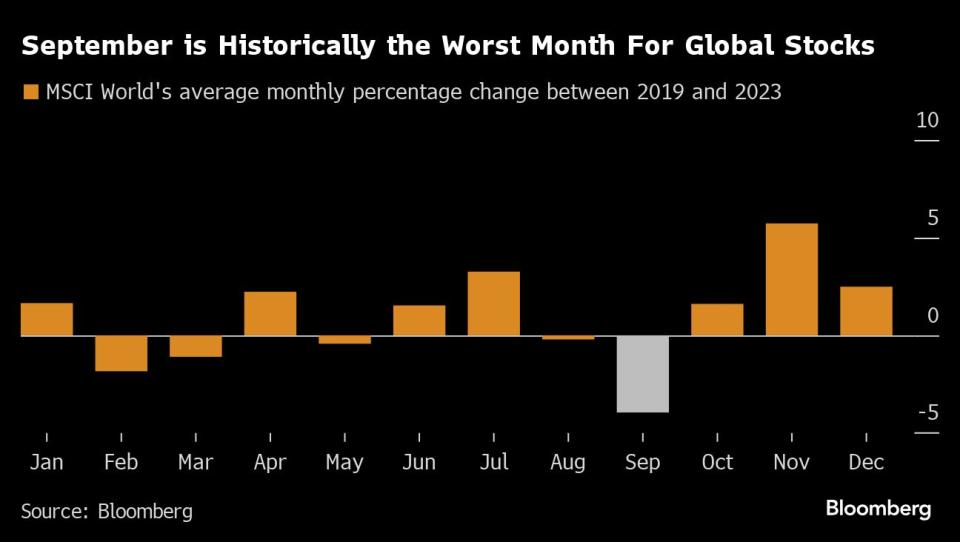Treacherous September Is Leaving Traders Everywhere on Edge
(Bloomberg) -- September has traditionally been a terrible month for traders and risks being even harder to navigate in 2024 given lingering questions about the Federal Reserve’s anticipated interest-rate cut.
Most Read from Bloomberg
Bonds, stocks and gold have typically suffered losses in the month, as traders reassessed their portfolios after the summer break. The S&P 500 Index and Dow Jones Industrial Average have had their biggest percentage losses since 1950 in the month of September. Bonds have slid in eight of the last 10 Septembers, while bullion has dropped every time since 2017.
Investors may need to prepare for stormier weather this time, facing uncertainties including a crucial US jobs report seen key to the magnitude and frequency of the Fed’s future interest-rate cuts. Stocks trading near records and Treasuries enjoying their longest monthly winning streak in three years look vulnerable to data shocks or surprises from a tight US presidential race.
“Fall comes with falls — especially with markets pricing in so much for Fed cuts and people chasing the ‘Goldilocks’ scenario out there,” said Vishnu Varathan, head of economics and strategy at Mizuho Bank in Singapore. “Markets would be more edgy than normal.”
Fresh from a hectic August that featured a brief but brutal global stock rout, investors now look to Friday’s employment data that may shed light on the health of the world’s No. 1 economy and shape the trajectory of the Fed’s upcoming monetary easing campaign.
With a hefty four quarter-point rate cuts currently priced in by the end of this year, there’s heightened risk for wild market swings if the Fed sounds less dovish than expected at its meeting that concludes on Sept. 18.
“September seasonality has a checkered record, with risk-off not uncommon and in election years more dramatic,” Bob Savage, head of markets strategy and insights at BNY, wrote in a note. “There is a sense that the US jobs report ahead will determine the course for the rest of the year.”
The S&P 500 has fallen in each of the last four Septembers and this time the non-farm payrolls data may carry added weight for US stocks.
“The market is currently driven by a few mega-cap tech stocks, making it vulnerable to significant drawdowns if these stocks falter,” said Manish Bhargava, chief executive officer at Straits Investment Management in Singapore. “Any surprise could lead to a rapid unwinding of leveraged positions.”
Another source of volatility is Vice President Kamala Harris and former President Donald Trump’s first TV debate next week, an event considered pivotal to the momentum of their campaigns as the election enters its final stretch.
One risk is “the idea of a contested election like what we saw in 2000,” Amy Wu Silverman, head of derivatives strategy at RBC Capital Markets, wrote in a note. While Fed Chair Jerome Powell has “pretty much removed any debate of ‘Will they, or won’t they?’ for a September rate cut, the big question is ‘How much?’”
Given the high stakes, strategists say caution will be key to navigating markets.
Hedging has been looking “cheap for quite a while,” according to RBC Capital Markets, while LPL Financial sees opportunity in US communication services, energy and health-care stocks. For the current equity market trajectory to remain intact, growth and easy policy will be required, according to BNY.
“Buckle up and ensure extra protection is in place,” said Hebe Chen, an analyst at IG Markets Ltd.
--With assistance from Joanna Ossinger.
(Adds context on S&P 500 in paragraph eight.)
Most Read from Bloomberg Businessweek
Need 100,000 Balloons for a Convention? Here’s the Guy to Call
Hong Kong’s Old Airport Becomes Symbol of City’s Property Pain
How TikTok Turned Starface’s Pimple Patches Into a Beauty Obsession
?2024 Bloomberg L.P.


